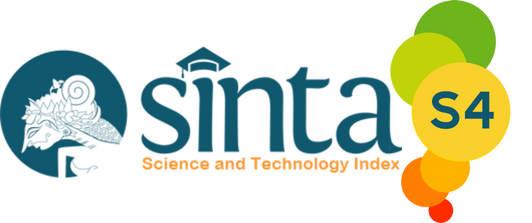Strategi Peningkatan Adopsi Masyarakat terhadap Urban Farming Toga di Hunian Padat Kota Solo
Abstract
This study aimed to identify internal and external factors and determine alternative strategies for improvement of communities’ adoption toga at crowded occupancy in Solo. Basic method of the research was descriptive qualitative. The technique of determining informants with the purposive sampling. The data was obtained through observation, deep interview, FGS, and document study. The research location was purposely determined by referring to active participation from communities in supporting the greening program in Solo, namely Serengan Urban Village. This urban village is quite active in supporting the greening program in Solo. The result showed that there were six strength and nine weaknesses as internal factors, seven opportunities and six threats as external factors. The result of IFE table showed that value of 3.058 meant strong and value in EFE of 2.915 meant medium. Based on the analysis of those two matrixes, it was found that the matrix result of IE was in category four, growing and building, so that in SWOT matrix, the researcher offered five strategies for improvement of urban farming TOGA adoption; (1) Improving experience and knowledge from communities to conduct urban farming TOGA, both in the cultivation and the utilization, 2) Improving communities’ awareness about the potential and opportunities of urban farming TOGA, 3) Improving communities’ ability to conduct the TOGA maintenance through assistance, 4) Improving communities’ knowledge and modal by building cooperation with other parties, 5) Encouraging farmers to build cooperation with government and other institutions for increasing experience in technology, maintenance, and sale.
Keywords
Full Text:
PDFReferences
Adeosun, O., Adeosun, T.H., & Adetunde, I. A. (2009). Strategic Application of Information and Communication Technology for Effective Service Delivery in Banking Industry. Journal of Social Science, 5(1), 47-51
Bailkey, M., & Nasr, J. (2000). From Brownfields to Greenfields: Producing Food in North American Cities. Community Food Security News. Fall 1999/Winter.
Buhalis, D. (1998). Strategic use of information technologies in the tourism industry. Tourism Management, 19(5), 409–421.
Butler, L., & Moronek, D. M. (2002). Urban and Agriculture Communities: Opportunities for Common Ground. Ames, Iowa: Council for Agricultural Science and Technology.
Rangkuti, F, (2004), Analisis SWOT Teknik Membedah Kasus Bisnis, PT. Gramedia, Jakarta.
Hamdan, H. (2018). Industri 4.0: Pengaruh Revolusi Industri Pada Kewirausahaan Demi Kemandirian Ekonomi. Jurnal Nusantara Aplikasi Manajemen Bisnis, 3(2), 1-8.
Jalaludin, R. (2000). Psikologi Komunikasi. Bandung: Remaja Rosdakarya.
Slabinski, J. M. (2012). From Wasteland To Oasis: How Pennsylvania Can Appropriate Vacant Urban Land Into Functional Space Via Urban Farming. Widener Law Journal, 22(1), 253–287.
Setiawan, B., & Rahmi, D. H. (2004). Ketahanan Pangan, Lapangan Kerja, dan Keberlanjutan Kota: Studi Pertanian Kota di Enam Kota di Indonesia. Warta Penelitian Universitas Gadjah Mada (edisi khusus). Hal 34-42.
Subarjo, A. H. (2017). Perkembangan Teknologi dan Pentingnya Literasi Informasi untuk Mendukung Ketahanan Nasional. Jurnal Ilmiah Bidang Teknologi Angkasa, 11(2).
Sumbodo, B. A. A., Dharmawan, A., & Faizah, F. (2017). Implementasi Teknologi Internet Sebagai Solusi Pengentasan Masalah Komunikasi di Desa Nyamuk, Kecamatan Karimunjawa, Kabupaten Jepara. Jurnal Pengabdian kepada Masyarakat (Indonesian Journal of Community Engagement), 2(2), 189-203.
Zein, U. (2005). Pemanfaatan Tumbuhan Obat dalam Upaya Pemeliharaan Kesehatan. E-USU Repository, (23), 1–7.
Wiyanti, A. N. (2013). Implementasi Program Urban Farming Pada Kelompok Sumber Trisno Alami Di Kecamatan Bulak Kota Surabaya. Journal of Chemical Information and Modeling, 53(9), 1689–1699
Refbacks
- There are currently no refbacks.






